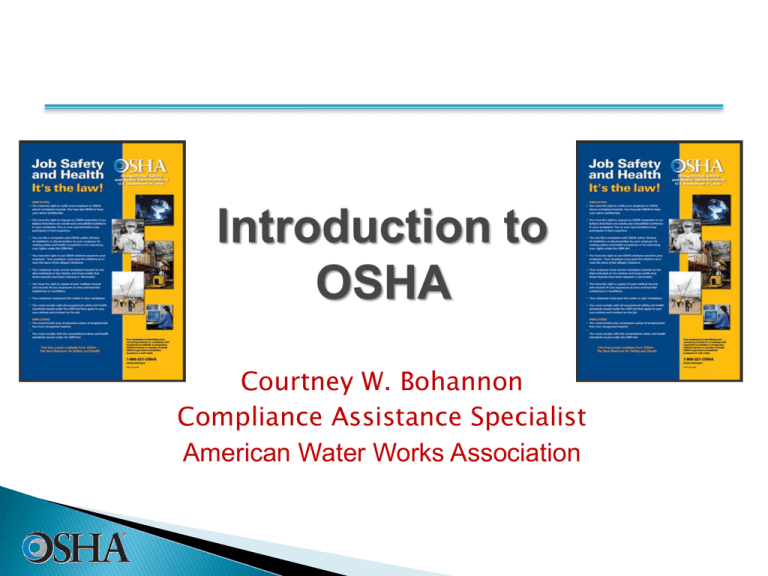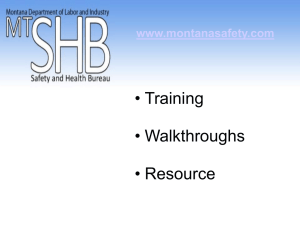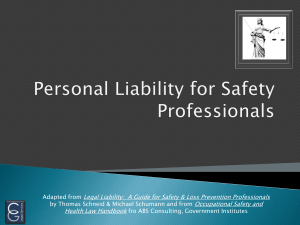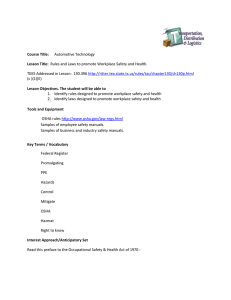Presentation - AL/MS Section of AWWA
advertisement

Courtney W. Bohannon Compliance Assistance Specialist American Water Works Association 1 Why is OSHA Important to You? OSHA began because, until 1970, there were no national laws for safety and health hazards. On average, 12 workers die every day from job injuries Over 5,600 Americans die from workplace injuries annually Over 4 million non-fatal workplace injuries and illnesses are reported 2 History of OSHA OSHA stands for the Occupational Safety and Health Administration, an agency of the U.S. Department of Labor OSHA’s responsibility is worker safety and health protection On December 29, 1970, President Nixon signed the OSH Act This Act created OSHA, the agency, which formally came into being on April 28, 1971 3 OSHA’s Mission The mission of OSHA is to save lives, prevent injuries and protect the health of America’s workers. Some of the things OSHA does to carry out its mission are: ◦ developing job safety and health standards and enforcing them through worksite inspections, ◦ maintaining a reporting and recordkeeping system to keep track of job-related injuries and illnesses, and ◦ providing training programs to increase knowledge about occupational safety and health. 4 Who is covered by the OSH Act? • Most private sector employees • Coverage is provided directly by federal OSHA or through an OSHA-approved state program • OSH Act does not apply where other Federal agencies exercise authority over occupational safety and health • In Mississippi OSHA does not cover city, county and state employees. 5 Typical Questions Why did we show up on your jobsite? How many inspectors do we have? Do we give warnings I’m an LLC, am I covered? Am I covered if I don’t have any employees? Am I covered if I contract out all work? 6 Fatality Reporting Must report within 8 hours. Reports may be filed by calling: 601 - 965 - 4606. 1 - 800 - 321 - OSHA. Must talk to someone. Can not leave a message. Failure to report a fatality or catastrophe can result in a $5,000.00 penalty. 7 Investigations Phone/Fax Onsite 8 Mississippi Data Conducted 558 Inspections 78% of Citations were serious Serious citations averaged $1,939.00 4 Significant cases Received 396 complaints ◦ 229 Investigated ◦ 109 Inspected 9 The creation of OSHA provided workers the right to a safe and healthful workplace. Section 5(a)(1) of the OSH Act states: “Each employer shall furnish to each of his employees employment and a place of employment which are free from recognized hazards that are causing or are likely to cause death or serious physical harm to his employees." 10 Employers must have a written, complete hazard communication program that includes information on: Container labeling, Material Safety Data Sheets (MSDSs), and Worker training. The training must include the physical and health hazards of the chemicals and how workers can protect themselves; including specific procedures the employer has implemented to protect workers, such as work practices, emergency procedures, and personal protective equipment. 11 OSHA’s Recordkeeping rule requires most employers with more than 10 workers to keep a log of injuries and illnesses. Workers have the right to review the current log, as well as the logs stored for the past 5 years. Workers also have the right to view the annually posted summary of the injuries and illnesses (OSHA 300A). 12 Workers may bring up safety and health concerns in the workplace to their employers without fear of discharge or discrimination, as long as the complaint is made in good faith. OSHA regulations [29CFR 1977.9(c)] protect workers who complain to their employer about unsafe or unhealthful conditions in the workplace. 13 Workers have a right to get training from employers on a variety of health and safety hazards and standards that employers must follow. Some required training covers topics such as, lockout-tagout, bloodborne pathogens, noise, confined spaces, fall hazards in construction, personal protective equipment, along with a variety of other subjects. 15 Employer Responsibilities Provide a workplace free from recognized hazards and comply with OSHA standards Provide training required by OSHA standards Keep records of injuries and illnesses Provide medical exams when required by OSHA standards and provide workers access to their exposure and medical records Not discriminate against workers who exercise their rights under the Act (Section 11(c)) Post OSHA citations and abatement verification notices Provide and pay for PPE 16 How Are inspections Conducted The OSH Act authorizes OSHA compliance safety and health officers (CSHOs) to conduct workplace inspections at reasonable times. OSHA conducts inspections without advance notice, except in rare circumstances (e.g. Imminent Danger) In fact, anyone who tells an employer about an OSHA inspection in advance can receive fines and a jail term. 17 Priority 1st Category of Inspection Imminent Danger: Reasonable certainty an immediate danger exists 2nd Fatality/Catastrophe: Reported to OSHA; inspected ASAP 3rd Complaints/Referrals: Worker or worker representative can file a complaint about a safety or health hazard 4th Programmed Inspections: Cover industries and employers with high injury and illness rates, specific hazards, or other exposures. 18 VIOLATION TYPE PENALTY WILLFUL A violation that the employer intentionally and knowingly commits or a violation that the employer commits with plain indifference to the law. OSHA may propose penalties of up to $70,000 for each willful violation, with a minimum penalty of $5,000 for each willful violation. SERIOUS A violation where there is substantial probability that death or serious physical harm could result and that the employer knew, or should have known, of the hazard. There is a mandatory penalty for serious violations which may be up to $7,000. OTHER-THAN-SERIOUS A violation that has a direct relationship to safety and health, but probably would not cause death or serious physical harm. OSHA may propose a penalty of up to $7,000 for each other-than-serious violation. REPEATED A violation that is the same or similar to a previous violation. OSHA may propose penalties of up to $70,000 for each repeated violation. 19 Temporary Workers "We are seeing untrained workers – many of them temporary workers – killed very soon after starting a new job. This must stop," said Michaels. "Employers must train all employees, including temporary workers, on the hazards specific to that workplace – before they start working. Distracted Drivers Companies are in violation of the Occupational Safety and Health Act if, by policy or practice, they require texting while driving, or create incentives that encourage or condone it, or they structure work so that texting is a practical necessity for workers to carry out their job. Excavation Review 24 Excavation Hazards Cave-ins are the greatest risk Other hazards include: Asphyxiation due to lack of oxygen Inhalation of toxic materials Fire Moving machinery near the edge of the excavation can cause a collapse Accidental severing of underground utility lines 25 Myth or Reality If I am working in a trench less than 5 feet in depth, I don’t need to worry about cave-in protection? 26 Injury and Death • Excavating is one of the most hazardous construction operations • Most accidents occur in trenches 5-15 feet deep • There is usually no warning before a cave-in 27 Cave-in Hazard This excavation has inadequate support posts and egress access Inadequate protective system 28 Inadequate Protective System This worker is in a trench with no protective system, that is not sloped or benched and has no means of egress 29 Trenching Fatality “We could not use the trench box because the trench was not straight!” 30 5 Days Before Christmas! “But he was only going to be down there for 5 minutes!” 31 Underground Utilities The estimated location of utilities shall be determined prior to the start of excavation work. Utility owners shall be contacted in order to determine the exact location of the utilities. Underground utilities shall be protected or removed to safeguard employees. 32 Access Designed by competent person < 25’ from employees 33 Access and Egress 34 Public Vehicular Traffic Employees exposed to vehicular traffic shall be provided with and shall wear warning vests or other suitable garments marked with or made of reflective or high-visibility material. 35 Falling Loads No employee shall be permitted underneath loads handled by digging or lifting equipment. 36 Competent Person A person who is capable of identifying existing and predictable hazards in the surroundings, or working conditions which are unsanitary, hazardous, or dangerous to employees, and who has AUTHORIZATION to take prompt correction measures to eliminate them. 37 Competent Person Must have had specific training in and be knowledgeable about: •Soils classification •The use of protective systems •The requirements of the standard Must be capable of identifying hazards, and authorized to immediately eliminate hazards 38 Hazardous Conditions The weight and vibrations of the crane make this a very hazardous condition. They should not be working under this crane. 39 Spoils • Don’t place spoils within 2 feet from edge of excavation • Measure from nearest part of the spoil to the excavation edge • Place spoils so rainwater runs away from the excavation • Place spoil well away from the excavation 40 41 Inspections of Excavations A competent person must make daily inspections of excavations, areas around them and protective systems: • Before work starts and as needed, • After rainstorms, high winds or other occurrence which may increase hazards, and • When you can reasonably anticipate an employee will be exposed to hazards. 42 Inspections of Excavations If the competent person finds evidence of a possible cave-in, indications of failure of protective systems, hazardous atmospheres, or other hazardous conditions: Exposed employees must be removed from the hazardous area Employees may not return until the necessary precautions have been taken 43 44 Site Evaluation Planning Before beginning excavation: Evaluate soil conditions Construct protective systems Test for low oxygen, hazardous fumes and toxic gases Provide safe in and out access Contact utilities Determine the safety equipment needed 45 http://www.buildsafe .org/ 46 47 Courtney W. Bohannon USDOL – OSHA Jackson Area Office 100 W. Capitol Street Suite 749 Jackson, MS 39269-1620 601-965-4606 ext. 2035 bohannon.courtney@dol.gov 48






